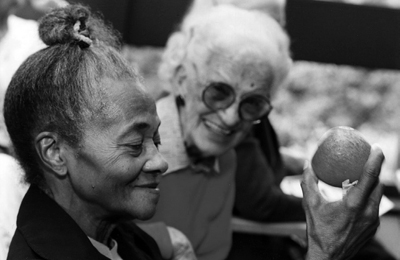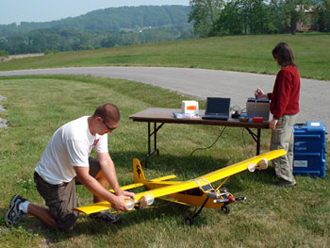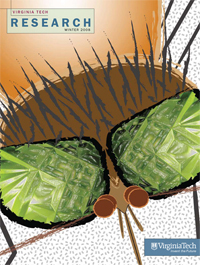|
Hok-E-News, Virginia Tech Magazine's online-only feature, is updated quarterly.
 Veterinary college's Meng awarded nearly $3 million in grants to study hepatitis E virus Veterinary college's Meng awarded nearly $3 million in grants to study hepatitis E virus
by Jeffrey Douglas
|
|
|
|
Dr. X.J. Meng, of Blacksburg, Va., a professor of virology in the Virginia-Maryland Regional College of Veterinary Medicine's Department of Biomedical Sciences and Pathobiology at Virginia Tech, has been awarded two research grants totaling almost $3 million from the National Institutes of Health to study the hepatitis E virus.
The ultimate goal of the work is to develop a vaccine to protect people and animals from hepatitis E (commonly referred to as HEV).
"This is an exceptional achievement," said Dr. Gerhardt Schurig, dean of the Virginia-Maryland Regional College of Veterinary Medicine. "The environment for [National Institutes of Health] funding is more competitive than ever, so I think this makes a major statement about the world-class nature of Dr. Meng's work."
|
|
|
|
|
|
|
|
Hepatitis E is an important human pathogen, according to Meng. The disease, caused by the hepatitis E virus, is a major public health problem in developing countries in Asia and Africa and in Mexico. The virus is also endemic in the United States and many other industrialized countries, according to Meng. Although the overall mortality associated with infection is generally low (less than 1 percent), it can be as high as 28 percent in infected pregnant women. Currently, there is no vaccine to prevent hepatitis E.
The major obstacle for hepatitis E research and vaccine development has been the lack of a practical animal model system for research on the virus and the inability to propagate it in cell culture, explains Meng.
With funding from the National Institutes of Health, Meng's group recently discovered two hepatitis E-related animal viruses in the United States: swine hepatitis E virus (swine HEV) from pigs and avian hepatitis E virus (avian HEV) from chickens. It has since been demonstrated that swine hepatitis E can cross species-barriers and infect humans and that human hepatitis E can infect pigs. It is now regarded as a zoonotic disease.
With the discoveries of the two new animal viruses, Meng's group quickly developed a pig model and a chicken model to study the hepatitis E virus. Prior to Meng's discoveries of the two animal hepatitis E viruses, scientists were forced to use non-human primates in order to study the disease. Conducting hepatitis E research with primates at one of the National Institutes of Health regional primate centers is expensive and contains some ethical concerns, according to Meng, so developing the new animal models will be a major step forward in the research.
The first grant, entitled "Mechanism of hepatitis E virus replication and pathogenesis," conveys total funding of $1,561,797, and the co-investigators are Dr. Patrick G. Halbur and Dr. Yao-Wei Huang. The second grant, entitled "A chicken model to study hepatitis E virus pathogenesis" includes funding of $1,266,300, and the co-investigators are Dr. F. William Pierson, Dr. Tanya LeRoith, and Dr. Yao-Wei Huang. Both grants began on March 1, 2008, and will support four years of work.
The grants will enable researchers to learn more about the molecular mechanisms of hepatitis E replication and pathogenesis by using pigs and chickens as animal model systems. Specifically, the researchers will study how the virus causes hepatitis, the gene(s) that are responsible for virulence, the mechanism(s) for cross-species infection by the hepatitis E virus, and how to attenuate the virus for vaccine development purpose. Ultimately, the researchers hope to develop a vaccine against this important human pathogen.
Meng's laboratory in the college's Center for Molecular Medicine and Infectious Disease is considered one of the world's leading hepatitis E virus research centers. Previously, he had received nearly $2 million dollars from the National Institutes of Health to study the same virus. Meng currently chairs the Hepatitis E Virus Study Group on the International Committee on Taxonomy of Viruses.
Funded by the U.S. Department of Agriculture and several private corporations, Meng's lab also studies several economically important animal viruses, including porcine circovirues and porcine reproductive and respiratory syndrome virus. Recently, Meng's lab successfully developed the first United States Department of Agriculture fully-licensed vaccine, Suvaxyn® PCV2 One Dose™, against porcine circovirus-associated diseases, an economically important swine disease worldwide. Virginia Tech has licensed the vaccine to Wyeth Inc. and Fort Dodge Animal Health Inc., and the vaccine is currently on the United States and Canadian markets and has now begun to enter the global markets. The vaccine is saving millions of dollars each year for the swine industry.
Prior to joining the college in 1999, Meng served as senior staff fellow of the Molecular Hepatitis Section of the Laboratory of Infectious Diseases at the National Institutes of Health's National Institute of Allergy and Infectious Diseases. Meng earned his doctor of medicine from Binzhou Medical College in Binzhou, Shandong, People's Republic of China; a master's degree in microbiology and immunology from the Virus Research Institute, Wuhan University College of Medicine in Wuhan, Hubei, Peoples Republic of China; and a doctorate in immunobiology from the Department of Microbiology, Immunology, and Preventive Medicine at the Iowa State University College of Veterinary Medicine in Ames, Iowa.
[ top ]
|
 Families need help coping with so-called mild cognitive impairment, research shows Families need help coping with so-called mild cognitive impairment, research shows
by Susan Trulove |
|
|
|

|
|
The age-related memory condition known as mild cognitive impairment is more disruptive of day-to-day life and relationships than once believed, gerontology researchers at Virginia Tech have discovered.
Funded by the Alzheimer's Association, Karen Roberto, director of the Center for Gerontology at Virginia Tech, and Rosemary Blieszner, associate director, set out to determine the issues and needs of families responding to mild cognitive impairment. After interviews with 99 families, the researchers reported, "Primary family members reported that their relatives were experiencing memory-related changes that interfere with their daily activities and responsibilities, decision-making processes, and relationships."
|
|
| "For the first three-year study, we interviewed each family member twice," Roberto said. "The first time was within six months of receiving the diagnosis. For instance, we asked why they went to the memory clinic."
The research identified three types of responses from people diagnosed with the impairment. "Some elders were strategists; their memory loss was apparent to them and they wanted to find out all they could about what it is, why it is occurring, and what they could do about it. They had already begun working through potential changes in their lives," the researchers report.
Older adults in the second group appeared more uncertain. They did not appear to recognize that they have memory changes and did not understand why they needed to be tested. And a few older adults appeared troubled by their condition. "They are not accepting of the memory changes. Although they did not acknowledge problems willingly, we sensed that they realize things were not quite right."
The second interview was a year later to learn how families were coping.
"Care partners reported distress at having to take on the other person's responsibilities or at the changes in the marriage or parent-child relationship. There was also frustration at the changes in daily routine," Roberto said.
"The care partner experiences a loss of independence and a loss of time for personal interests," said Blieszner. "The definition of [mild cognitive impairment] has been that it does not significantly affect daily life--but sometimes that is not true."
The finding is significant because problems early in care giving have long-term implications for the individual providing care and their feelings of burden and depression if the impairment progresses to Alzheimer's disease, the researchers advised the association. "Professionals need to provide information, assistance, coping strategies, and support to family members at this stage in the care process rather than waiting until Alzheimer's disease is diagnosed."
The researchers also asked the families the type of information they would like to have. In response, the Center for Gerontology published a brochure for families, "Mild Cognitive Impairment--What do we do now?"
The brochure contains information on how to recognize symptoms and when to seek a professional diagnosis. The researchers emphasize that contrary to common belief, memory loss is not a normal part of aging, which is why diagnosis is important to rule out other conditions, as well as to provide treatment.
Also in the brochure, both family members and professionals offer strategies for compensating for memory loss and provide advice to the care partner on how to care for oneself. And, the Center for Gerontology brochure suggests how to prepare for the future.
There were 99 economically diverse families in the original study. "A family is three people," explained Roberto. "One member is 60 or older, with mild cognitive impairment, and able to be interviewed. The second is the primary care partner--as distinguished from care giver. So, this is not a professional care giver but a family member, usually the spouse. The third family member is the secondary care partner and usually not living in the home, such as an adult child, friend, or sibling."
The second three-year phase of the study began in October 2007. "We continue to follow the families and look at incidence of transition from mild cognitive impairment to Alzheimer's," Roberto said. "And we are adding 40 families that reflect racial and ethnic diversity."
For the first study, families were identified in cooperation with the Center for Healthy Aging Clinic of the Carilion Health System in Roanoke, Va., the Eastern Virginia Medical School in Norfolk, Va., and the Memory Disorders Clinic at the Veteran's Administration Medical Center in Salem, Va. For phase two, the University of Chicago Medical School has joined the study.
There is a difference between forgetfulness and memory loss, Roberto said. "Forgetfulness is often situational or a result of not giving attention to the information presented such as a person's name or directions. It can also be caused by information overload, such as sorting through too many e-mails. Memory loss starts presenting itself more consistently and often includes episodes of confusion or lack of awareness."
On March 26, 2008, the Center for Gerontology at Virginia Tech celebrated 30 years of scientific, educational, and outreach accomplishments. The center's mission is to foster and facilitate multidisciplinary research that enhances the quality of life of older adults. The center focuses primarily on family gerontology, health and aging, and elder rights. The mild cognitive impairment research is an example of family gerontology and health and aging. In addition to the core faculty, there are more than 70 faculty affiliates doing such work. The center has been awarding graduate certificates since 1985 and is one of the first graduate study programs awarded the Program of Merit distinction by the Association for Gerontology in Higher Education.
[ top ]
|
|
 Scientists to study high-risk plant pathogen using small, unmanned aircraft Scientists to study high-risk plant pathogen using small, unmanned aircraft
by Michael Sutphin
|
|
 |
|
 |
|
|
|
|
A Virginia Tech plant pathologist known for his investigation of microbial life in the lower atmosphere is using unmanned aerial vehicles (UAVs) in a new, three-year study to detect, monitor, and forecast the spread of a fungus-like organism responsible for the Irish Potato Famine in the 1840s and 1850s. This famine resulted in the deaths of more than 1 million people in Ireland and caused at least 1.5 million more to flee the country.
David Schmale, assistant professor of plant pathology, physiology, and weed science in the College of Agriculture and Life Sciences, hopes that a recent grant of nearly $1 million from the U.S. Department of Agriculture (USDA) will help scientists better understand how Phytophthora infestans, a high-risk plant pathogen that causes late blight of potato and tomato, is transported through the atmosphere.
Other researchers on this project are Elson Shields, professor of entomology at Cornell University, and Donald Aylor, distinguished scientist at the Connecticut Agricultural Experiment Station.
"Today, more than 150 years after the Irish Potato Famine, P. infestans is still a major problem and a potential biosecurity threat," said Schmale, who pointed out that Virginia's last major outbreak of P. infestans was along the Eastern Shore in 1996. "Currently, there are no commercial varieties of potato that are completely resistant to the pathogen. The ability to track the movement of P. infestans in the atmosphere may assist in making rational and informed management decisions."
Schmale has added six new hobby-size planes to his "air force" of nine UAVs. With the help of the Virginia Center for Autonomous Systems, a Virginia Tech research center that facilitates collaboration in autonomous systems technologies, he has retrofitted these small aircraft with unique collection plates that open while the plane is in flight above potato fields at Virginia Tech's Kentland Farm. The UAVs can collect samples of P. infestans tens to hundreds of meters above agricultural fields.
Schmale purchased state-of-the-art equipment that will enable him to detect and quantify P. infestans at the Kentland Farm within a matter of minutes following sample collection. Schmale and colleagues are using this data to generate a long-distance transport model for P. infestans, which may be integrated into a 3-D map viewable in Google Earth.
"This research will allow scientists to know where this pathogen could move and what strategies we could use to mitigate it if an epidemic occurs," Schmale said. "One outcome of this project will be the development of an online resource that provides growers and producers with rapid forecasting of the potential spread of late blight so they can take appropriate measures to safeguard their crops."
The USDA grant also provides funding for a new undergraduate course in the Department of Plant Pathology, Physiology, and Weed Science on "aerobiology"--the study of how organisms are transported in the atmosphere. The course, which begins in the third year of the grant, will be the first of its kind at Virginia Tech and will involve students participating in hands-on projects in aerobiology, biosecurity, and environmental science.
A previous article and a short video from University Relations have more information about Schmale's use of UAVs to study the transport of microbes in the lower atmosphere.
[ top ]
|
|
|
|
|
|
|
 |
|
Read about more Virginia Tech discoveries -- including preventing natural disasters, learning how the sun works, and designing modern kitchens--in the latest issue of Virginia Tech Research magazine.
|
|
|
|
|
|

